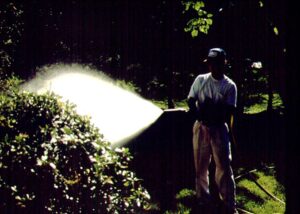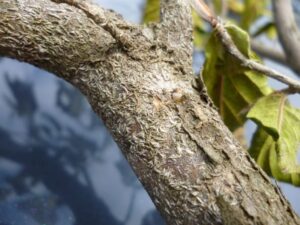Grape and Wine Science Certificate Program will be offered July 22-Aug 16, 2024. This program will provide foundational knowledge in three major areas of grape and wine science – grape growing, wine making, and business operations – following the path of grapes from the field to the winery to the glass. Students will gain competency in all three areas to prepare them for positions in the industry. The program will feature 4 weeks of classroom instruction, complemented by hands-on workshops. Then students will complete a 4-week winery internship where they can put their new knowledge and skills into practice. [Read more…]
Nursery Update 5/20/24 – Red-headed flea beetle and flathead borer ADULT emergence, Boxwood blight, bagworms, more
Please note: The Rutgers Nursery and Green Industry Working Group is working to deliver regular pest and disease updates throughout the season. These will be in addition to important alerts, critical topics, and pesticide credit opportunities. This tool is made for you, the commercial agriculture business, so please let us know if there are particular topics you would like to see included in the regular update.
Email: twaller@njaes.rutgers.edu Phone: 856-451-2800 Ext. 1.
| Projected GDD50 accumulation as of 5/20/2024 (for June – July) | ||||||
| CODE | Location | 20-May | 1-Jun | 15-Jun | 1-Jul | 15-Jul |
| NJ50 | Upper Deerfield (South) | 437 | 658 | 957 | 1363 | 1766 |
| NJ73 | Vineland (South) | 454 | 670 | 961 | 1360 | 1755 |
| KMIV | Millville Airport (South) | 445 | 655 | 942 | 1338 | 1730 |
| NJ05 | Greenwich (South) | 453 | 681 | 984 | 1395 | 1798 |
| NJ10 | Howell (Central) | 344 | 545 | 809 | 1180 | 1554 |
| N59 | High Point (North) | 275 | 463 | 683 | 997 | 1316 |
| USPEST.ORG – Model: simple average/growing degree-day, Min: 50F – Max: 95F, NMME forecast | ||||||
| Forecast: 7-month NMME based seasonal climate forecast (USPEST.ORG) – Subject to change regularly = Check Often | ||||||
Please download and print the Rutgers Nursery and Landscape Pest Scouting Guide or Conifer and Christmas Tree Pest Scouting Guide and refer to this post “Obtaining your local growing degree-days (GDD)” for additional information. (See pest scouting guides for complete list of references)
Please SHARE what you SEE!! If you see a pest, disease, otherwise interesting or troublesome issue please report it to the Working Group by following the QR Code on the front of the Pest Scouting Guides or by filling out this reporting form.
Keep reading for more ALERTS – Red-headed flea beetle and Borer ADULT EMERGENCE, Boxwood Blight, bagworms [Read more…]
Nursery Update 4/30/24 -Boxwood blight, borers, flea beetles
Please note: The Rutgers Nursery and Green Industry Working Group is working to deliver regular pest and disease updates throughout the season. These will be in addition to important alerts, critical topics, and pesticide credit opportunities. This tool is made for you, the commercial agriculture business, so please let us know if there are particular topics you would like to see included in the regular update.
Email: twaller@njaes.rutgers.edu Phone: 856-451-2800 Ext. 1.
Insect Pests
| Projected GDD50 accumulation as of 4/30/2024 | ||||||
| CODE | Location | 1-Apr | 1-May | 1-Jun | 1-Jul | 1-Aug |
| NJ50 | Upper Deerfield (South) | 47 | 237 | 696 | 1408 | 2308 |
| D4116 | Bridgeton (South) | 45 | 172 | 632 | 1346 | 2243 |
| KMIV | Millville Airport (South) | 57 | 249 | 676 | 1362 | 2237 |
| NJ05 | Greenwich (South) | 53 | 247 | 716 | 1436 | 2338 |
| NJ10 | Howell (Central) | 33 | 172 | 551 | 1191 | 2026 |
| N59 | High Point (North) | 18 | 117 | 440 | 990 | 1711 |
| USPEST.ORG – Model: simple average/growing degree-day, Min: 50F – Max: 95F, NMME forecast | ||||||
| Forecast: 7-month NMME based seasonal climate forecast (USPEST.ORG) – Subject to change regularly = Check Often | ||||||
Please download and print the Rutgers Nursery and Landscape Pest Scouting Guide or Conifer and Christmas Tree Pest Scouting Guide and refer to this post “Obtaining your local growing degree-days (GDD)” for additional information. (See pest scouting guides for complete list of references)
Please SHARE what you SEE!! If you see a pest, disease, otherwise interesting or troublesome issue please report it to the Working Group by following the QR Code on the front of the Pest Scouting Guides or by filling out this reporting form.
Keep reading for more ALERTS – Boxwood Blight risk this week – Red-headed flea beetle timing, borer activity, and upcoming pests.
Last Minute Reminder – Tonight – Annual NJ Farm Labor Regulatory Update in Mays Landing
7pm tonight, Thurs, April 11, 2024
Rutgers Cooperative Extension of Atlantic County office
6260 Old Harding Hwy
Mays Landing, NJ 08330
- in collaboration with NJ Farm Bureau, we bring in representatives from the US and NJ Dept of Labor, and several other speakers dealing with agricultural labor issues. Hope you can join us.
Immediate Potential for Boxwood Blight Throughout NJ THIS WEEK
| Boxwood Blight Risk Assessment as of 4/10/2024 | |||||||||
| Region | Location | CODE | 10-Apr | 11-Apr | 12-Apr | 13-Apr | 14-Apr | 15-Apr | |
| Southern | Upper Deerfield | NJ50 | Very Low | Minor Risk | High Risk | Very Low | Very Low | Very Low | |
| Central | Howell / Freehold | NJ10 | Low | Low | High Risk | Very Low | Very Low | Very Low | |
| Northern | High Point | NJ59 | Very Low | High Risk | VERY High Risk | Very Low | Very Low | Very Low | |
| W | TH | F | S | Sun | M | ||||
| Please check YOUR LOCAL risk (click here) | |||||||||
There is a potential for boxwood blight infections this Thursday and Friday throughout ALL of NJ. Incoming rains, coupled with consistent temperatures may initiate boxwood blight infections this week.
-
It is time to begin protective fungicide applications in boxwoods throughout the state if you have not already done so.
- If BWB is important to your business – Use the USPEST – PUSH Alerts – (click here) – to setup weekly email alerts. Create an account, watch the tutorial, and then set up your subscriptions. You select which locations (as many as you like), days you want to receive emails (pick Sunday/Monday), and what you would like to receive alerts about (BWB and a variety of other pests and diseases). Rutgers is not directly affiliated, however this is an incredible tool.
Dormant Oil Applications for Landscapes
Dormant Oil Guidelines:
Dormant oils at 2-4% rates in the late fall & late winter seasons can aid in the control of overwintering insects and insect eggs. Consider treating for such pests as aphids (eggs), southern red mites/eggs, spruce spider mites/eggs, oak spider mites (eggs), eriophyid mites/eggs, spruce gall adelgids, lace bugs (deciduous plants), cankerworms (eggs), leaftiers, psyllids, plant bugs, etc.
Some landscapers have been successful applying both late fall and early spring dormant oil treatments to the same plants on the same properties. This is a reasonable approach since a single dormant oil treatment will not provide 100% control and it gives the field technician another opportunity to monitor the landscape for problems.

Dormant oil sprays require excellent coverage & often repeat applications. (Photo Credit: Steven K. Rettke, Rutgers Coop. Ext.)

Japanese maple scale infested branch will likely require multiple dormant oil treatments to suppress. (Photo Credit: Steven K. Rettke, Rutgers Coop. Ext.)
